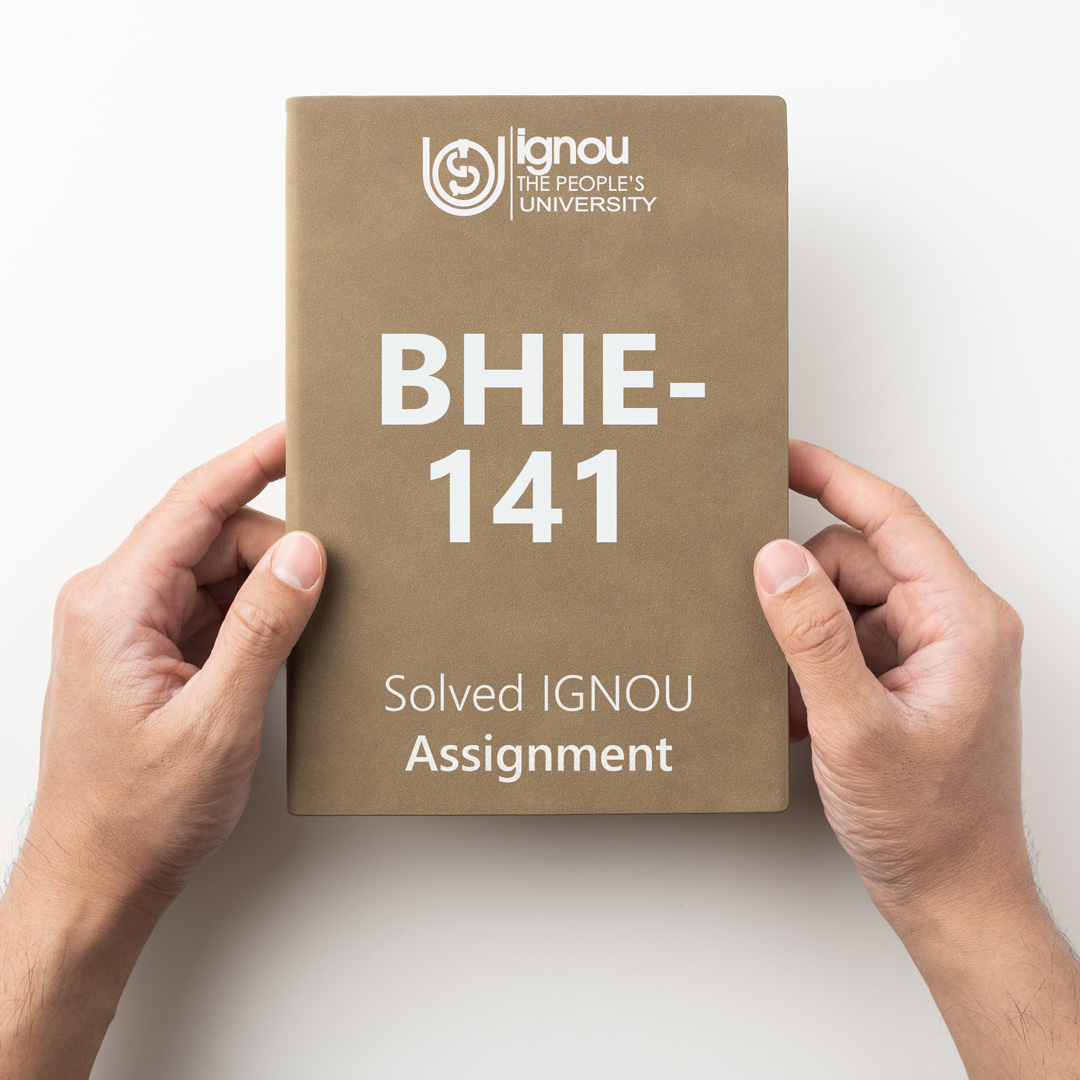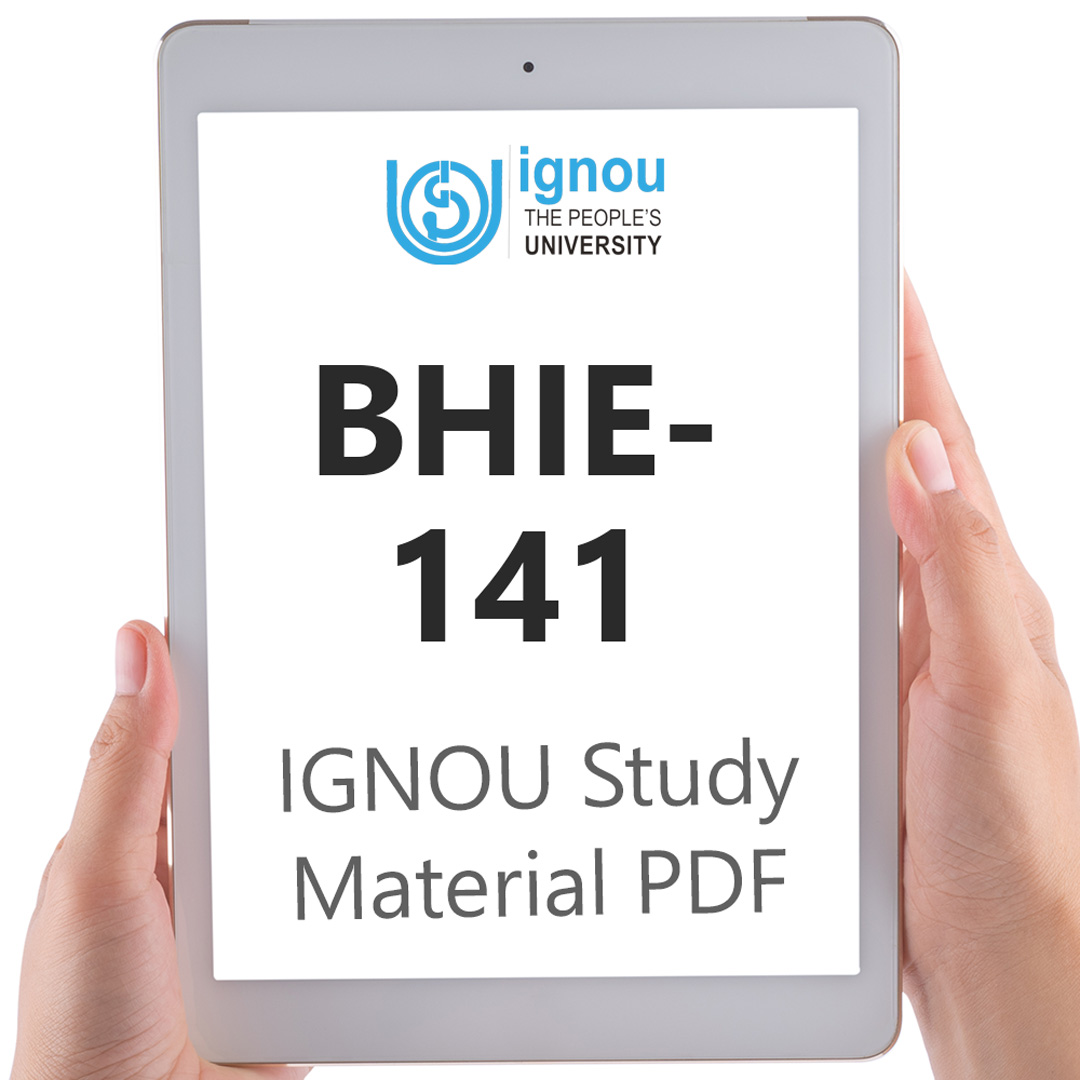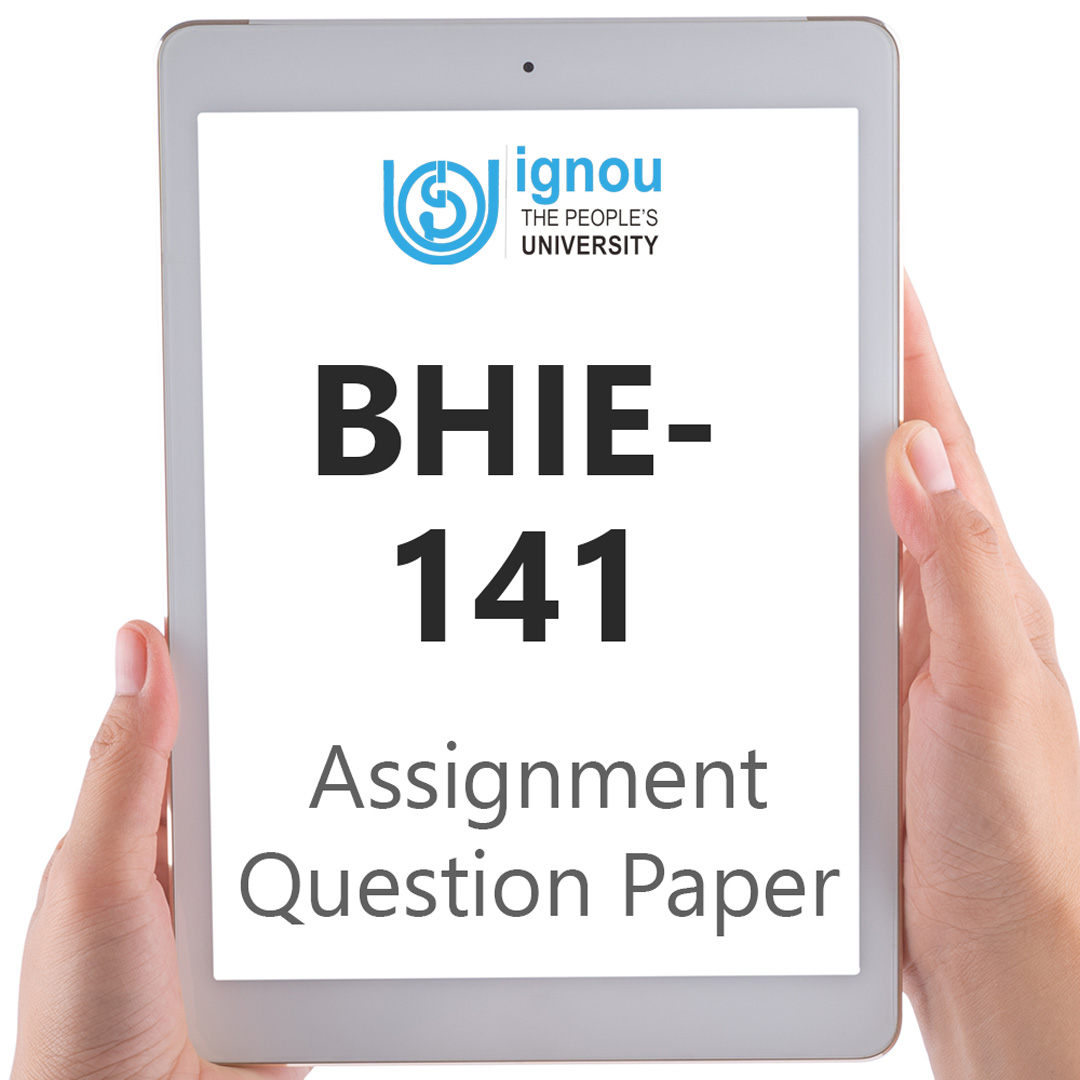If you are looking for BHIE-141 IGNOU Solved Assignment solution for the subject Economics of Health and Education, you have come to the right place. BHIE-141 solution on this page applies to 2022-23 session students studying in BAHIH, BAG courses of IGNOU.
BHIE-141 Solved Assignment Solution by Gyaniversity
Assignment Code: BHIE-141/ASST/TMA/2022-2023
Course Code: BHIE-141
Assignment Name: History of China (C. 1840–1978)
Year: 2022-2023
Verification Status: Verified by Professor
There are three Sections in the Assignment. You have to answer all questions in the Sections.
Section-I
Answer the following in about 500 words each. 20x2
Q1) Write a note on the New Cultural Movement in China after 1911. Discuss the role of intellectuals in China’s Cultural Revolution.
Ans) The New Culture Movement was a movement that advocated a new Chinese culture based on progressive, contemporary, and western principles like democracy and science during the 1910s and 1920s in China. The rebellion against Confucianism was led by scholars like Chen Duxiu, Cai Yuanpei, Chen Hengzhe, Li Dazhao, Lu Xun, Zhou Zuoren, He Dong, Qian Xuantong, Liu Bannong, Bing Xin, and Hu Shih, many of whom had received a classical education. It was born out of disillusionment with traditional Chinese culture after the Republic of China failed to address China's problems.
The movement was started by the New Youth magazine writers, who advocated for a new society centred on free individuals as opposed to the conventional Confucian system. The May Fourth Movement had its roots in the New Culture Movement. The movement, which had originally been a cultural one, became a political one on May 4, 1919, when students in Beijing who were affiliated with it opposed the Paris Peace Conference's awarding of German rights over Jiaozhou Bay to Imperial Japan rather than China.
Intellectuals in China’s Cultural Revolution
Most notably, the May Fourth Movement, or rather how it combined with the New Culture movement, gave rise to a variety of doctrines that would later find expression in a variety of new journals. The New Culture's "totalistic" rejection of cultural heritage simply signified an explosive stage in the broadening of the audience for these topics on May Fourth.
The ramifications of these occurrences for the simply cultural diagnosis of China's illness are one of the key effects of this situation. The May Fourth Incident was a political protest against foreign imperialism that appeared to be successful. It also functioned for a while as a sort of mass movement. The domestic problems in China were the new cultural leaders' main focus in the past.
Even the apolitical Hu Shi was compelled to reconsider his position in light of the May Fourth events. By observing that the student organisations had moved into popular education, social and philanthropic work, and intense intellectual discussion, John Dewey, who was also in China in 1919, reinforced this ambition. The initial premise appears to have been that all of these objectives could be achieved by avoiding the insurmountable realities of political and military power as they were in 1919 China. The liberal demand for civil rights in opposition to the arbitrary actions of the government was thus one part of his political activism.
Hu Shin also advocated for a "government with a plan" and a "government of good men" on the opposing ends of his political debates. He could only hope that persons of scientific enlightenment may use their influence to exert pressure on established censurers of power given that he had already brought out the serious issue of how to tie "science" to "democracy" in China given that country's circumstances. Hu felt compelled to believe in an intelligent elite, no less than the communists and nationalists. The possibility of cooperating with the Warlord administration was, of course, doomed to failure, and Hu Shi was shortly to revert to his cultural interpretation of China's issues.
One of the organisations better prepared to capitalise on the nationalist political fervour that gripped the youth on May Fourth was Sun Yatsen and his entourage. He had not been side-tracked from his political objective of establishing a powerful central authority during the entire dark era between 1911 and 1919. His belief in Western-style constitutional democracy increasingly waned. Younger followers of his showed a remarkable openness to the Leninist idea of imperialism as a description of Western conduct.
Q2) Analyze the economic, social, and political programme of People’s Republic in China.
Ans) With the Communist triumph, a government of this type was founded in China. It was a coalition of fourteen parties and organisations, and both the administration and the deputy heads of state included non-Communists. This political system served as a representation of the new regime's widespread support. In social terms, it constituted an alliance or united front between the bourgeoisie, peasantry, working class, and peasants. Mao Zedong was appointed as the People's Republic's Chairman.
Land Reforms
The implementation of land reform was the first significant policy. It followed that:
As much as practicable, all land should be distributed equitably throughout the community or district.
Only those who were willing to work it themselves were to receive the former landlords' tiny share, which would be equal to everyone else's.
The agrarian policy was moderate and designed to maintain support from the majority of Chinese people in the rural, in keeping with the broad foundation of the new political organisation. It was therefore more reasonable than the Civil War policy.
In contrast to the Agrarian Law of 1947, the Agrarian Law of 1950 separated landowners' rural holdings and possessions without providing them with compensation, but it left them in control of their city homes and businesses. Again, unlike in 1947, the wealthy peasants were permitted to keep their lands and holdings, with consideration given to their level of productivity and the need to supply rice to cities.
The political influence of the landlords was further undermined by the creation of peoples' courts and peasants groups. The peasants felt extremely confident as a result. In all regions of China, landowners who were cruel and tyrannical were subjected to widespread trials. After these trials, some landlords received death sentences; depending on their offences, some received jail sentences; and yet others received only an apology. Some people became so overpowered by their intense animosity that they occasionally decided to take matters into their own hands.
Agrarian reform also aided in reviving village social life. Peasants associations organised health and literacy programmes, while women's organisations, young people's organisations, and other initiatives also made sure that all demographic groups took part in the reform of the populace's way of life.
Industry
The national bourgeoisie controlled the management of industry, and the Communists had very little influence over it. Through the 1950 statute, their main concerns were with governmental orders, distribution of primary resources, price regulation, and labour unions. The CPC set up an extensive network of unions in factories, city federations, provinces, and many industrial sectors. They ran literacy initiatives and represented workers' interests in the enterprises. Under the overall control of the state, private economic activity was permitted to grow and even turn a profit. Corruption, waste, bribery, and other such vices that hindered output were combated tenaciously.
Social Change
The Marriage Law of 1950 was a significant turning point in the evolution of social interactions. The establishment of equal rights for women was its main objective. The status of women was greatly enhanced by making marriage an institution founded on equality and free mutual agreement. Women actively participated in productive employment and social responsibility. They started taking part in civic life in the new China.
The Marriage Law also served as a child protection measure. Infanticide of females was strongly prohibited. Children could not be sold, despite the fact that it had occurred often during the famines of 1921, 1931, and 1943. Many women who were forcibly married sought divorces and received assistance from women's organisations. Prostitution was made illegal. The prostitutes received medical attention as well as emotional support as they started new lives.
Section-II
Answer the following questions in about 250 words each. 10x3
Q1) Analyse the significance of the Opium Wars in the evolution of the Sino-Western relation in the 19th Century.
Ans) An aspect of what is more frequently observed that Chinese perceptions of the West have a strong historicist dimension is the extent to which the writing of history in the West may have influenced and is currently affecting Western views of the relationship with China. In terms of public remarks, the latter is easily discernible, but the former is more evasive and suggestive. However, this does not make it any less important.
Two aspects emerge: first, the degree to which the treatment of China results from generalised elements, or, in other words, from a Western account of the West and, consequently, from the West against the rest. Second, and also overlapping but distinct, is the extent to which specific judgments of China are relevant, not the least of which is the notion of a distinct Chinese strategic culture, which has been widely used since the 1970s. The former is immediately obvious.
The West has been the main focus of military history, with the "rising of the West" as its dominant meta-narrative. This comprehensive analysis, which has undergone different explanations and is now old, tends to focus on the role of military technology as a cause and an effect of Western victory. The rest of the world is portrayed in this storey primarily as a failure. Although this failure has multiple dates and explanations, it overshadows the military history of the rest.
Q2) Write a note on Confucianism and Taoism.
Ans)
Confucianism
Confucianism is a philosophy and belief system from ancient China, which laid the foundation for much of Chinese culture. Confucius was a philosopher and teacher who lived from 551 to 479 B.C.E. His thoughts on ethics, good behavior, and moral character were written down by his disciples in several books, the most important being the Lunyu. Confucianism believes in ancestor worship and human-centered virtues for living a peaceful life. The golden rule of Confucianism is “Do not do unto others what you would not want others to do unto you.”
The main idea of Confucianism is the importance of having a good moral character, which can then affect the world around that person through the idea of “cosmic harmony.” If the emperor has moral perfection, his rule will be peaceful and benevolent. Natural disasters and conflict are the result of straying from the ancient teachings. This moral character is achieved through the virtue of ren, or “humanity,” which leads to more virtuous behaviours, such as respect, altruism, and humility.
Taoism
Taoism is a religion and a philosophy from ancient China that has influenced folk and national belief. Taoism has been connected to the philosopher Lao Tzu, who around 500 B.C.E. wrote the main book of Taoism, the Tao Te Ching. Taoism holds that humans and animals should live in balance with the Tao, or the universe. Taoists believe in spiritual immortality, where the spirit of the body joins the universe after death.
One of the main ideas of Taoism is the belief in balancing forces, or yin and yang. These ideas represent matching pairs, such as light and dark, hot, and cold, action and inaction, which work together toward a universal whole. Yin and yang show that everything in the universe is connected and that nothing makes sense by itself.
Q3) Discuss the emergence of the Chinese bourgeoisie as a social force.
Ans) The upheaval of 1911 marked the establishment of the bourgeoisie as a major force in the economic and social life of China. Since the 18th century, due to demographic changes, the pace of urbanization in China was accelerated. This also increased the number of traders and merchants who bought commodities including food grains from the villages and sold them in towns and cities. With the intervention of the West in a more aggressive form since the Opium Wars, tremendous economic changes were visible in the coastal areas of China, many of which were Treaty Ports. The dominant urban class merchants as well as scholar officials saw this as an opportunity for profit. The merchants had wealth, entrepreneurial skill, and willingness to try out innovations.
The 1911 Revolution had weakened the position of the mandarins. Obviously, commercial ventures became a good alternative to achieve economic status if not political power. The outbreak of the First World War in 1914 was, however, a watershed in the development of the native Chinese bourgeoisie. The new class now sprang into action as the temporary withdrawal of foreign competition opened new markets for it, both within China and outside. Expansion and diversification of business opened up new business avenues. We find that the bankers and industrialists became the leading players in the Chinese urban economic scene. The war time and early post-war years are termed as the golden age of the Chinese bourgeoisie. The year 1927 was another turning point for this class when a bureaucratic military control of north of China hindered the development of a free capitalist system.
Section-III
Answer the following questions in about 100 words each. 6x5
Q1) Write a note on Chinese Communist Party.
Ans) In Hunan, study groups were established by Mao Zedong and Zhou Enlai. There were a few communists from China who were also active in France. All of these events aided in attracting more intellectuals and students to the communist cause. In order to avoid being caught by the police, these organisations met in July 1921 in a girls' boarding school in Shanghai. Twelve delegates, representing 57 individuals from seven various groups, were present.
A representative of the Communist International was also present. The CPC's formation was settled upon here. The party's co-founders were named as Chen Duxiu and Li Dazhao because they were unable to attend the Congress due to severe police repression of communist organisations. The first Secretary-General of the Party was Chen Duxiu. The culmination of these factors international happenings, a burgeoning workers movement, a radicalising political environment, and the emergence of the notion of a revolution and a revolutionary party to lead it was the creation of the CPC. The political landscape of China was completely altered by this.
Q2) Explain the importance of the Self-Strengthening Movement.
Ans) In the 1870s and 1880s, their successors used their positions as provincial officials to build shipping, telegraph lines, and railways. China made substantial progress toward modernizing its heavy industry and military, but the majority of the ruling elite still subscribed to a conservative Confucian worldview, and the "self-strengtheners" were by and large uninterested in social reform beyond the scope of economic and military modernization. The Self-Strengthening Movement succeeded in securing the revival of the dynasty from the brink of eradication, sustaining it for another half-century. The considerable successes of the movement came to an abrupt end with China's defeat in the First Sino-Japanese War in 1895.
Q3) Discuss the consequences of the May Fourth incident.
Ans) Most notably, the May Fourth Movement, or rather how it combined with the New Culture movement, gave rise to a variety of doctrines that would later find expression in a variety of new journals. The New Culture's "totalistic" rejection of cultural heritage simply signified an explosive stage in the broadening of the audience for these topics on May Fourth. The ramifications of these occurrences for the simply cultural diagnosis of China's illness are one of the key effects of this situation.
The May Fourth Incident was a political protest against foreign imperialism that appeared to be successful. It also functioned for a while as a sort of mass movement. The domestic problems in China were the new cultural leaders' main focus in the past. One of the more recent additions to the theological and philosophical arsenal of the May Fourth era was the Russian Revolution and its dogma. In China, Leninist doctrine steadily gained acceptance. The intelligentsia developed a new breed of communists. Their objective changed to the broad mobilisation of a new, scientific culture. This massive mobilisation was intended to also be a source of military and political power.
Q4) How did Marxism emerge in China?
Ans) The deplorable living circumstances that prevailed among the working class throughout China served as the social context in which Marxism arose. For half a billion people, the only options available to them in the countryside were poverty, abuse, and early death.
It was a civilization where individuals were compelled that:
They sell their kids.
If things are horrible, eat grass and bark.
above their means in rent and taxes.
While all of this was happening, a few elite lived a life of luxury. The growing commercialization and monetization of rural areas in China linked the rural economy to the global capitalist system. However, it also caused the oppression of the peasantry to worsen. The landlords were also the source of the grain merchants, moneylenders, and administrative personnel who controlled the entire rural economy.
Q5) Briefly discuss post-Mao reforms in China.
Ans) At the Party's Eleventh Congress in 1977, Hua Guofeng made it apparent that he would follow Maoist doctrine when he asserted that class conflict is the crucial link. The fundamental turning point in Chinese politics occurred in December 1978, when Deng Xiaoping, then a Vice-Premier, declared that China will now go along the path of the Four Modernizations at the Third Plenum of the Eleventh Party Congress. These modernizations affected national defence, industry, agriculture, science, and technology. This suggested a major revision of the laws. Development was to take the place of Mao's egalitarianism.
Later, Reform and Opening Up were used to refer to the four Modernizations. This policy has radically changed China. China has advanced beyond Japan and is now just behind the United States in terms of GDP after three decades of pursuing rapid economic expansion and development. The Chinese state and society have experienced a period of relative stability since 1978.






